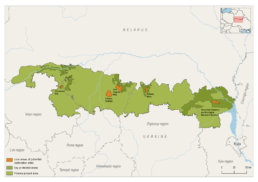Mid-Pripyat
This is a fragment of the Pripyat River valley in its middle course, winding for about 120 kilometers between the mouths of the Jasielda and Scviga rivers. It is one of Europe’s most expansive and untouched floodplains, a rare natural sanctuary.
Each spring, the river spills over its banks in a flood that can last for months. During this time, the water stretches across the landscape, transforming the floodplain into a vast wetland that can be from one to five kilometers wide.
The land here is mostly flat, though occasionally rumpled, and the river itself snakes across it in a series of curves. Forests cover about a third of the area, while a rich tapestry of grasslands – from waterlogged meadows to drier upland fields – covers another 30%. Open wetlands, dotted with precious and well-preserved lowland fens, make up about a fifth of the reserve; some of these have been managed as hayfields or pastures.
The numerous and inaccessible overgrown oxbow lakes and floodplain lakes, which occupy about 3% of the area, support an incredible variety of plant and animal life, making this landscape uniquely diverse and alive.

Country: Belarus
Area: 93,062.15 ha
National protection status: Nature Reserve
International protection status: Emerald Network* (BY0000005) – Srednyaya Pripyat (95,488.1 ha); Ramsar Site (BY1090) – Mid-Pripyat National Landscape Zakaznik (93,062 ha); IBA (BY017) – Mid Prypiac` (98,674 ha).
* After denunciation of accession to the Bern Convention on the Conservation of European Wildlife and Natural Habitats, de jure there are no Emerald Network sites in Belarus.
>100 000
individuals of migratory bird species registered on spring migration
30 key habitats
are included
in the Resolution #4
of the Standing Committee
to the Bern Convention
>100 species
found here are included in the Resolution #6 of the Standing Committee to the Bern Convention
Land cover

Forests

Grasslands

Open wetlands

Oxbow lakes and floodplain lakes

Others
Biodiversity and natural values

Habitats
This territory is a truly unique river valley, a vibrant mosaic of meadow, forest, and wetland habitats more than 30 of which require specific protection under the Resolution No. 4 of the Standing Committee to the Bern Convention. The nature reserve is particularly important for the conservation of the following valuable habitats in Belarus:
Aquatic Habitats
- Free-Floating Plant Communities (3150): Floating Frogbit Rafts, Floating Colonies of Bladderwort, Floating Mats of Salvinia natans, General Free-floating Vegetation of Eutrophic Waters;
- River Channel Vegetation: Eutrophic Vegetation of Slow-flowing Rivers (3260), Sparsely Vegetated River Gravel Banks;
- Water’s Edge (Littoral) Vegetation: Species-poor Beds of Low-growing Water-fringed Vegetation (3130), Euro-Siberian Dwarf Annual Amphibian Meadows (3270) – Pioneer vegetation on exposed mud;
Wetland Habitats
- Beds of Large Sedges (7210) – usually without standing water,
- Moist or Wet Eutrophic and Mesotrophic Grasslands (6440);
Woodland Habitats
- Riverine Forests: Riverine Willow Woods (91E0), Mixed Oak-Elm-Ash Woods of Large Rivers (91F0),
- Upland Forests: Oak-Ash-Hornbeam Woods (9170) – on nutrient-rich soils.



Biodiversity
The vegetation cover supports at least 725 plant species; wildlife includes more than 1,000 species of insects, 50 species of fish, 6 – reptiles, 12 – amphibians, and 248 species of birds, including 190 nesting species, as well as at least 55 species of mammals. The territory is of great importance for a number of species. The flora and fauna of the area include about 90 species listed in the Red Data Book of Belarus. Over 100 species are listed in the Resolution No 6 of the Standing Committee to the Bern Convention.
17 protected species of insects are registered in the Nature Reserve, including the Stag Beetle (Lucanus cervus), the Boros Schneideri, the Great Capricorn Beetle (Cerambyx cerdo), the False Ringlet (Coenonympha oedippus), the Danube Clouded Yellow (Colias myrmidone), the Scarce Large Blue (Maculinea teleius), the Water Beetle (Graphoderus bilineatus), the Dark Crimson Underwing (Catocala sponsa) and other species.
The territory is of exceptional importance for a number of fish species: the White-finned Gudgeon (Gobio albipinnatus), the Asp (Aspius aspius), the Ukrainian Brook Lamprey (Eudontomyzon mariae), аs well as of reptiles and amphibians: the European Pond Turtle (Emys orbicularis), the Crested Newt (Triturus cristatus), the Natterjack (Bufo calamita), the Fire-bellied Toad (Bombina bombina).

Birds
The Pripyat floodplain is of high international importance for numerous wetland bird species during their spring migration. The estimated number of spring migrants exceeds 100,000 individuals. Over 1% of the populations of 27 bird species in Belarus nest here. Among them are the Bittern (Botaurus stellaris), the Black Stork (Ciconia nigra), the Greater Spotted Eagle (Aquila clanga), the Lesser Spotted Eagle (Aquila pomarina), the Honey Buzzard (Pernis apivorus), the Crane (Grus grus), the Corncrake (Crex crex), the Little Crake (Porzana parva), the Great Snipe (Gallinago media), the Ruff (Philomachus pugnax), the Terek Sandpiper (Xenus cinereus), the Black Tern (Chlidonia sniger), the White-backed Woodpecker (Dendrocopos leucotos), the Aquatic Warbler (Acrocephalus paludicola), the Azure Tit (Parus cyanus), and others.

The most important impacts and threats

Meadows overgrowing with scrubs

Forest felling, dead wood removal

Spring bird hunting

River straigtening and damming
Grassland ecosystems are threatened by overgrowing with scrubs due to abandonment of haying and grazing, conversion of floodplains to cropland, cereal cultivation, overgrazing by livestock, as well as spring and autumn burning. Damage to forest habitats and species is caused by clear-cutting, sanitary logging, deadwood removal and forest plantation, while wetland ecosystems suffer from riverbed straightening, dredging and damming. In addition, spring hunting is detrimental to waterfowl and wading birds.
Protection and conservation needs
In the Mid-Pripyat National Landscape Reserve, drainage, construction, clearcut logging as well as some other activities are restricted. A part of protected species’ habitats and valuable biotopes are handed over under the land-users’ protection.
The existing protection regime is not sufficient to preserve species and biotopes. Among the recommended protection measures are:
- Compilation of a detailed inventory of rare species’ habitats;
- Subsequent handing them over under the land-users’ protection;
- Consistent monitoring of natural values.
Our activities in the area
A management plan for the reserve was developed (covering three administrative districts). Field work was carried out to identify rare biotopes and habitats of species listed in the Red Data Book in order to put them under legal protection.



The project “Polesia – Wilderness Without Borders” is part of the Endangered Landscapes & Seascapes Programme and is funded by Arcadia. The project is coordinated by Frankfurt Zoological Society (FZS).

